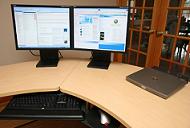 We’ve written before how adding a second (or third) monitor to an advisor’s workspace can unlock additional productivity (Increase Adviser Productivity At Least 10%).
We’ve written before how adding a second (or third) monitor to an advisor’s workspace can unlock additional productivity (Increase Adviser Productivity At Least 10%).
Now there’s a discussion developing on the Lifehacker website over whether the gain in productivity is actually true or not.
Click here to read Is the Multiple-Monitor Productivity Boost a Myth? at Lifehacker.com
The debate circles around the overall screen real estate available (e.g. pixels) when working with multiple programs and talks about settings for screen resolution and monitor size. I believe that one can be just as efficient when working on one large monitor with suitable dimensions compared to two monitors that feature an equivalent resolution.
Still, the argument that multiple monitors does not add to one’s productivity is not absolute. It depends on several factors that vary significantly from user to user.
So my takeaway for advisors considering multiple monitors is as follows:
- 20″ widescreen monitors should be sufficient to display large records side-by-side.
- Choose one monitor for your active workspace and one for your reference materials. Try not to switch back and forth between monitors to display active programs. Choose one and stick with it.
- Finally, don’t leave any email program active on any monitor at any time!




